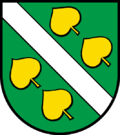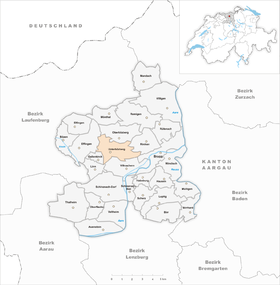Untersözberg
| Untersözberg | ||
|---|---|---|
| State : |
|
|
| Canton : |
|
|
| District : | Brugg | |
| Residential municipality : | Bozberg | |
| Postal code : | 5224 | |
| Coordinates : | 654 147 / 259.43 thousand | |
| Height : | 507 m above sea level M. | |
| Residents: | 742 (December 31, 2012) | |
| Website: | www.unterboezberg.ch | |
|
Kirchbözberg with reformed church |
||
| map | ||
|
|
||
Unterbözberg ( Swiss German : ˈʊn.dər.bœts.bɛrg ) was an independent community in the Swiss canton of Aargau that consisted of several hamlets until 2012 . It belonged to the Brugg district and was incorporated into the new Bözberg community on January 1, 2013 .
geography
The former community, located around four kilometers west of the district capital on the Bözberg Pass , had no actual center, but comprised various hamlets on a gently sloping plateau. Neustalden ( 569 m above sea level ) and Vierlinden ( 514 m above sea level ) are located directly on the Bözberg pass road . Altstalden ( 583 m above sea level ), Birch ( 557 m above sea level ), Ursprung ( 507 m above sea level ) and Hafen ( 485 m above sea level ) (each from the west) are a maximum of half a kilometer north of it seen to the east). Egenwil ( 565 m above sea level ) and Kirchbözberg ( 479 m above sea level ) are about one and a half kilometers north of the pass road and beyond the Reinerbach . The infrastructure facilities such as post office, municipal administration and school are concentrated in the hamlet of Ursprung, which is located roughly in the middle of the former municipal area. Neu-Stalden is right on the top of the pass.
The area of the former municipality was 611 hectares . The highest point was on the Homberg northwest of Egenwil at 608 meters, the lowest at 420 meters on the pass road near Hafen. Neighboring communities were Oberbözberg in the north, Riniken in the east, Brugg in the southeast, Villnachern in the south, Gallenkirch and Linn in the southeast and Effingen in the west.
history
The Romans already used the Bözberg as a pass crossing between Augusta Raurica and Vindonissa . The Roman road then ran a little further north than it does today, from Effingen via Oberbözberg to Stilli , where it met the road to Vindonissa ( Windisch ). In the 5th or 6th century, the Alemanni settled and founded several scattered settlements. In 1189, Bozeberch was mentioned for the first time when Pope Clement III. Confirmed property of Muri Monastery . The place name comes from the Latin (ad montem) Vocetum , whereby Vocetum goes back to the Celtic word Voceton , which can be translated as forest or wood.
.
In the Middle Ages, the Habsburgs began to extend their domain to include the Bözberg. For this purpose, in the 13th century they combined their possessions in this area to form the Bözberg court. In addition to Unter- and Oberbözberg, this also included Lauffohr , Linn , Mönthal , Rein , Remigen , Riniken , Rüfenach , Stilli and Villigen . In these villages the Habsburgs exercised blood jurisdiction , in Mönthal, Remigen and Villigen also the lower jurisdiction . The court changed hands several times from 1348 onwards by pledging and in 1377 it finally came under the rule of Schenkenberg .
The city of Bern occupied the rule militarily in 1460 and added it to the other subject areas in the Bernese Aargau . In 1528 the Bernese introduced the Reformation . In 1566 the judicial district was divided into an upper district with Bözberg and Linn and a lower district with the other villages. In 1779 a new Bözberg pass road was built via Vierlinden and Neustalden, which replaced the old route via Oberbözberg. In March 1798 the French took Switzerland, ousted the «Gracious Lords» of Bern and proclaimed the Helvetic Republic . Since then, the Bözberg has belonged to the canton of Aargau.
After the mediation in 1803, Bözberg was the largest municipality in the Brugg district. But it had no real center and the individual settlements were sometimes miles apart. In the 19th century there were several attempts to divide the community, with the initiative always coming from Oberbözberg, which felt neglected. Four applications in 1826, 1836, 1858 and 1870 were unsuccessful due to resistance from the cantonal authorities, and in 1858 a division into three municipalities was even planned. The fifth attempt was successful on September 24, 1872, when the Grand Council decided to divide it into two communities.
Unto the middle of the 20th century, Unterbözberg remained a pure farming community. Between 1880 and 1900 the population decreased by almost a fifth, but slowly increased again in the following decades. With the expansion of the nearby Bözbergstrasse, Unterbözberg gradually transformed into an easily accessible residential community. Lively construction activity led to an increase of over a quarter from 1980.
On December 2, 2011, the community assembly approved the merger agreement with the neighboring communities of Linn, Gallenkirch and Oberbözberg. The voters confirmed this decision on March 11, 2012 in a vote with 232 votes to 181. The four municipalities merged on January 1, 2013 to form the new municipality of Bözberg .
Attractions
The Reformed Church in Kirchbözberg, first mentioned in 1227 as the parish church of St. Martin, was probably built in the 11th century at the intersection of the old Roman road and the road from Laufenburg to Brugg . It also served as a meeting place for the residents of the numerous scattered settlements. The basic structure is in the Romanesque style and was expanded in 1483 by lengthening the nave and additions in the Gothic style. In 1825 the original church tower on the east side was removed and nine years later it was replaced by a tower on the west side. The rectory was built in 1664/65 in the late Gothic style.
coat of arms
The blazon of the former municipal coat of arms reads: "In green, white, right sloping bar, each accompanied by two yellow linden leaves." The coat of arms in its current form has existed since 1962. The linden leaves stand for the Vierlinden district, while the sloping beam symbolizes the Bözberg pass road. The old coat of arms, which existed since the municipality was divided in 1872, showed four mighty linden trees on four hills, which, however, could not be represented in a heraldic way.
population
The population developed as follows (1803 to 1870 including Oberbözberg ) :
| year | 1764 | 1803 | 1850 | 1870 | 1900 | 1930 | 1950 | 1960 | 1970 | 1980 | 1990 | 2000 | 2010 |
| Residents | 344 | 827 | 1060 | 904 | 410 | 416 | 492 | 542 | 588 | 587 | 657 | 754 | 733 |
On December 31, 2012, 742 people lived in Unterbözberg, the proportion of foreigners was 8.5%. In the 2000 census, 55.7% described themselves as Reformed and 28.4% as Roman Catholic ; 15.9% were non-denominational or of another faith. 94.4% said German as their main language, 1.5% Albanian and 1.3% Italian .
traffic
Main road 3 runs through the former municipality from Basel over the Bözbergpass to Zurich . Since the opening of the A3 motorway in 1996, through traffic over the top of the pass has decreased significantly, which has resulted in a noticeable improvement in the quality of life. Unterbözberg is connected to the public transport network by two post bus lines. They lead from Brugg station over the pass road to Frick and with a detour via Oberbözberg to Linn .
Personalities
- Jakob Amsler-Laffon (1823–1912), mathematician, engineer and manufacturer
literature
- Michael Stettler , Emil Maurer : The art monuments of the canton of Aargau . Ed .: Society for Swiss Art History . Volume II: The districts of Lenzburg and Brugg. Birkhäuser Verlag, Basel 1953, DNB 750561750 .
Web links
- Max Baumann: Unterbözberg. In: Historical Lexicon of Switzerland .
Individual evidence
- ^ National map of Switzerland, sheets 1069 and 1070, Swisstopo
- ^ Beat Zehnder: The community names of the canton of Aargau . In: Historical Society of the Canton of Aargau (Ed.): Argovia . tape 100 . Verlag Sauerländer, Aarau 1991, ISBN 3-7941-3122-3 , p. 433-434 .
- ↑ Linn, Gallenkirch, Ober- and Unterbözberg merge to form the municipality of Bözberg. Aargauer Zeitung , March 11, 2012, accessed on March 11, 2012 .
- ^ Joseph Galliker, Marcel Giger: Municipal coat of arms of the Canton of Aargau . Lehrmittelverlag des Kantons Aargau, book 2004, ISBN 3-906738-07-8 , p. 297 .
- ↑ Population development in the municipalities of the Canton of Aargau since 1850. (Excel) In: Eidg. Volkszählung 2000. Statistics Aargau, 2001, archived from the original on October 8, 2018 ; accessed on June 10, 2019 .
- ↑ Swiss Federal Census 2000: Economic resident population by religious affiliation as well as by districts and municipalities. (Excel) Statistics Aargau, archived from the original on October 8, 2018 ; accessed on June 10, 2019 .
- ↑ Swiss Federal Census 2000: Economic resident population by main language as well as by districts and municipalities. (Excel) Statistics Aargau, archived from the original on August 10, 2018 ; accessed on June 10, 2019 .





